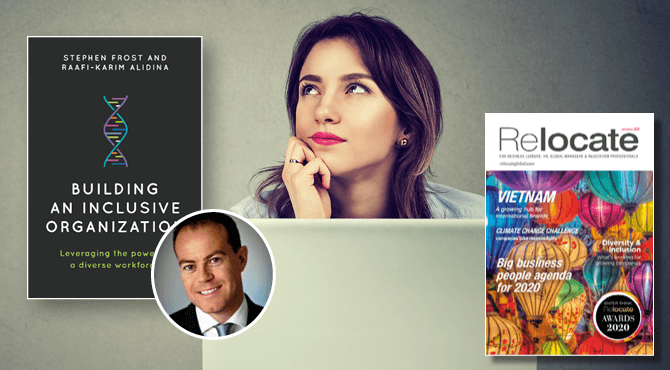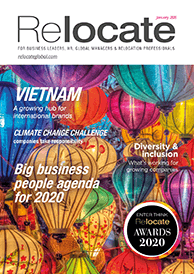How to outsmart your own bias for a better working environment
Understanding and working with your biases is a crucial skill for both employers and employees. While we may think we are not biased, often it can be unconscious. Author and consultant Stephen Frost explains how we can identify our biases and learn to overcome them in the workplace.

Click on the cover to access the digital edition and order your printed copy.
If you search for ‘three black teenagers’ on Google you will get some criminal looking mug shots. If you search for ‘three white teenagers’, you will get some smiley happy young people playing sport. This sums up what we have known for some time now – we are all deeply biased.Google acts as a window into our soul – a mirror to our unconscious. One of the reasons bias runs rampant is because we are not even aware we are biased in the first place. We assume our view is ‘normal’, our decisions are rational and our view of the world is the view of the world. Here are three ways to manage some of the most common biases we all share.
Do you want to help encourage a workforce where women thrive - and more? Come to our Think Women event on Women's Day 2020. Find out more.
Accept that you are biased, even if it is unconscious
First: understand that bias exists and we are all subject to it. We can think of ourselves as unconsciously incompetent. For example, we might publicly state that we don’t see colour. However, reflecting on our behaviour, it becomes clear we do. This is cognitive dissonance (the difference between our stated intention and actual behaviour).Unconscious bias needn’t only be negative – if we are about to have a car crash, we unconsciously physically react by stepping on the brake pad before we consciously react verbally. It’s about the difference between our conscious brain, where we reason (what Daniel Kahneman calls System 2 thinking) and the unconscious brain, where we react (System 1 thinking). Problems occur in the workplace when we are over-reliant on System 1 thinking, especially when dealing with people.Download our free Global Mobility Toolkit factsheets - on diversity, group moves, talent and career management, and many more topics
Becoming aware of your own biases
Second: become personally aware of your own biases. This is about becoming consciously incompetent! Only through becoming aware can we understand how those biases play out in reality. Take an implicit association test (IAT) to measure your implicit associations of people and stereotypes, and benchmark yourself against the rest of the population. Determine your ‘in-group’ by writing down your closest friends, colleagues, partner and neighbours. Then consider who is not ing this group – that’s your ‘out-group’. What are you doing to reach out to them? Finally, consider the simplicity of eliciting feedback from your colleagues, senior and junior, friend and foe.Act on your knowledge and find a new perspective
Third: now you are aware of some of your own biases, work out how you can minimise the negative ones. This is about becoming more consciously competent. Take an extra few seconds to breathe, count to 10 and shift your mind from System 1 to System 2 thinking. Move from unconscious knee-jerk reactions to more conscious reasoning. Get to know your out-group. Grab a coffee, have lunch, join an employee network, change your hot desk location. Try to get to know others and change your frame of reference. Finally, walk in someone else’s shoes – rotate the chair in meetings or simply listen to more/different perspectives.Unconscious-bias training is now standard practice in many organisations. It’s something I regularly teach. However, it’s only as useful as what you do with it. The real value is in how you apply it – to mitigate the negatives and make better decisions for you and your organisation.About the author
Stephen Frost is the co-author of Building An Inclusive Organization and the founder of Frost Included. Mr Frost has acted as an advisor to both the UK government and the White House, as well as KPMG, the BBC and Barclays. He was also the head of diversity and inclusion for the London Olympic and Paralympic Games. For more information go to www.frostincluded.com.If you liked this article, you might be interested in these related articles:
- LGBT+ Network strives for inclusive and diverse workplaces
- What inclusion means for LGBTQ employees: This Is Us 2019
- Bringing your whole self to work: why inclusion and authenticity are key to success
- Putting global people at the heart of good work
Read more articles in the Winter Issue of Relocate Magazine.
Subscribe to Relocate Extra, our monthly newsletter, to get all the latest international assignments and global mobility news.Relocate’s new Global Mobility Toolkit provides free information, practical advice and support for HR, global mobility managers and global teams operating overseas. Access hundreds of global services and suppliers in our Online Directory
Access hundreds of global services and suppliers in our Online Directory
©2025 Re:locate magazine, published by Profile Locations, Spray Hill, Hastings Road, Lamberhurst, Kent TN3 8JB. All rights reserved. This publication (or any part thereof) may not be reproduced in any form without the prior written permission of Profile Locations. Profile Locations accepts no liability for the accuracy of the contents or any opinions expressed herein.







































